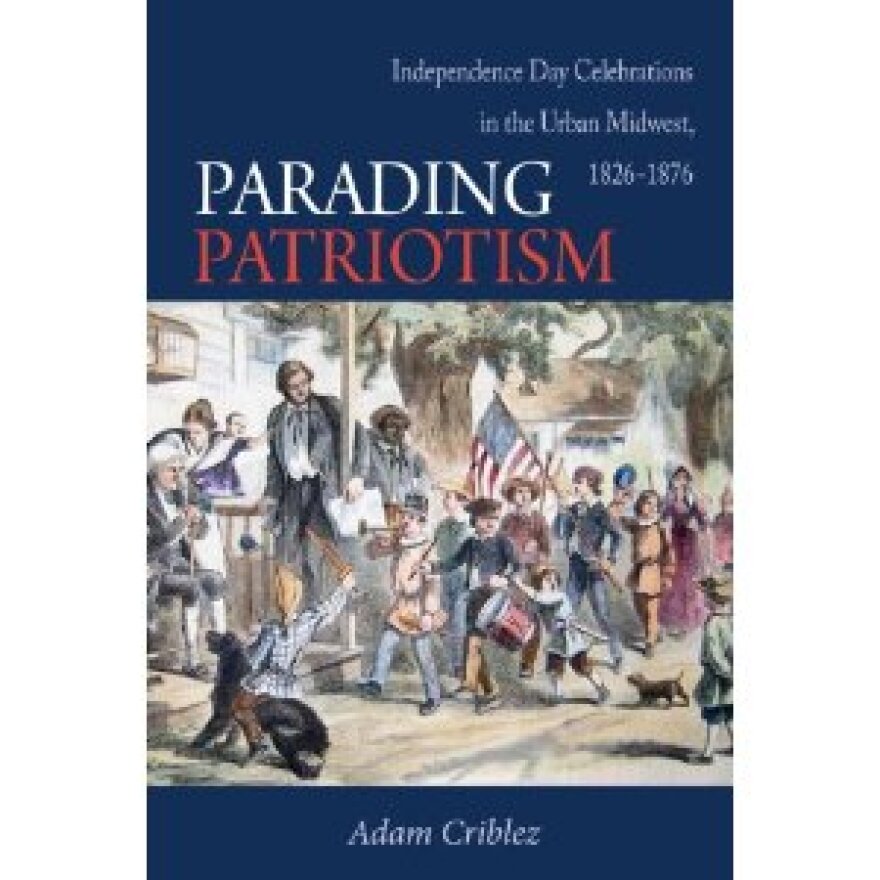The Fourth of July was a far different holiday in the early 1800’s from the one we know today, according to historian Adam Criblez in his new book, Parading Patriotism: Independence Day Celebrations in the Urban Midwest, 1826-1876. The book studies Fourth of July celebrations in five Midwestern cities: Cincinnati, Indianapolis, Chicago, Columbus and Cleveland.
Criblez, the director of the Center for Regional History at Southeast Missouri State University, said Fourth of July celebrations in the 1820’s and 1830’s were pretty typical for that time period. They started with an artillery reveille at dawn and were followed by shooting cannons or muskets into the air. A parade would begin at 8:00 a.m. or 9:00 a.m., and participants would then listen to a speaker at a courthouse or church.
“The designated speaker, who was often a lawyer or the mayor or if they were fortunate a state congressman, would come and give an oration, usually talking for between an hour and two hours,” Criblez said. “Many cases kind of blended a sermon with a political stump speech with invoking patriotism.”
After the speech, men would typically go to the tavern together while women would go serve the men in the tavern or go home with their families. The men would do thirteen regular toasts that were laid out in advance. The first toast would be for the current President, and the second would usually go to George Washington. The men’s thirteenth regular toast would be for women. After gulping down thirteen drinks, they would then continue with voluntary toasts.
Criblez said that pattern of celebration continued until about the 1850’s when the festivities began to change. By the end of the Civil War and the 1870’s, Fourth of July celebrations looked much more like modern festivities. Instead of big community celebrations, Midwesterners marked Independence Day with family and with small groups within the larger community.
“Instead of listening to public speeches, [they] might go to a picnic. Instead of going to a parade and marching, they would go to a baseball game. They would go to a horse race,” Criblez said.
The Civil War marked an important turning point for Fourth of July celebrations, and the holiday was celebrated far differently during that five year period than before or after the war. The Fourth of July in 1861 was decidedly militaristic, Criblez said.
“The men that happened to still be in town would march through the city streets armed to the teeth, followed by kids,” Criblez said. “There would be young boys especially, marching behind them with sticks to mimic their actions.” They would also hold sham battles where they portrayed what was occurring on battlefields.
By 1863, celebrations had shifted considerably and shied away from militarism. Instead, it became a day of escapism.
“It became a day where people could forget about the war, or at least could try to escape from the realities of it,” Criblez said. Fundraisers for orphans and widows replaced parades and sham battles.
Southern sympathizers in Midwestern cities like Cincinnati and Indianapolis celebrated the holiday quite differently, if they celebrated it at all. Confederate sympathizers saw themselves as the heirs to the American Revolution so they celebrated the Fourth of July in the old ways, while Unionists marked the occasion in smaller family units.
Following the Civil War, Criblez said African Americans were in a unique position because they had endured slavery and now wanted to celebrate, but they were scared because they were in the minority in the five Midwestern cities that Criblez studied.
“They feared that if they celebrated too exuberantly, that it would almost be rubbing it in the face of the whites in the area,” Criblez said.
He said most African Americans celebrated outside of town at parties that were advertised in local newspapers as “Young African Celebrations” or some other term that indicated it was specifically for African Americans. Others would celebrate on July 5 so that whites would not question their patriotism, but they could still thumb their nose at the establishment. Others celebrated the signing of the Emancipation Proclamation on January 1. The final day African Americans celebrated was June 14 - or Junteenth - which was the day that slaves in Texas learned of their emancipation.
Criblez developed an interest in how patriotism is expressed when in graduate school. He was focusing on public drinking and how people do and say outlandish things and let their guard down while intoxicated.
“A lot of the issues about public drinking and that sort of culture in the 19th Century revolved around the Fourth of July,” Criblez said. His research shifted from public drinking to the Fourth of July, celebrations and patriotism and how those topics are intertwined.
Parading Patriotism: Independence Day Celebrations in the Urban Midwest, 1826-1876 is published by Northern Illinois University Press.

